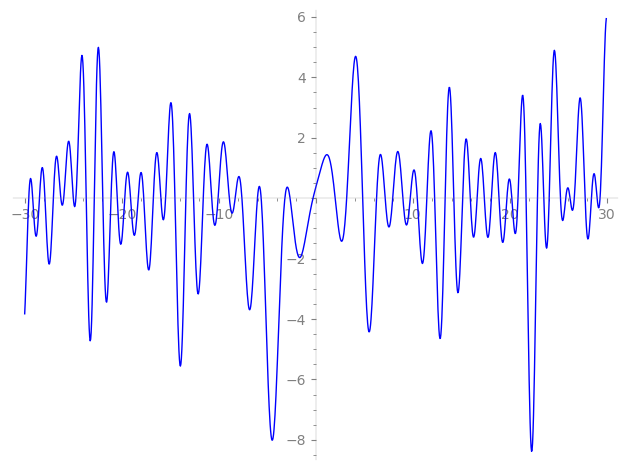| L(s) = 1 | + (−1.41 − 0.0660i)2-s + 0.496·3-s + (1.99 + 0.186i)4-s + (−0.701 − 0.0328i)6-s + (−1.55 + 1.55i)7-s + (−2.80 − 0.395i)8-s − 2.75·9-s + (−4.19 − 4.19i)11-s + (0.988 + 0.0927i)12-s − 5.09i·13-s + (2.29 − 2.09i)14-s + (3.93 + 0.743i)16-s + (−0.213 + 0.213i)17-s + (3.88 + 0.181i)18-s + (0.844 + 0.844i)19-s + ⋯ |
| L(s) = 1 | + (−0.998 − 0.0467i)2-s + 0.286·3-s + (0.995 + 0.0933i)4-s + (−0.286 − 0.0133i)6-s + (−0.587 + 0.587i)7-s + (−0.990 − 0.139i)8-s − 0.917·9-s + (−1.26 − 1.26i)11-s + (0.285 + 0.0267i)12-s − 1.41i·13-s + (0.614 − 0.559i)14-s + (0.982 + 0.185i)16-s + (−0.0517 + 0.0517i)17-s + (0.916 + 0.0428i)18-s + (0.193 + 0.193i)19-s + ⋯ |
\[\begin{aligned}\Lambda(s)=\mathstrut & 400 ^{s/2} \, \Gamma_{\C}(s) \, L(s)\cr =\mathstrut & (-0.725 + 0.688i)\, \overline{\Lambda}(2-s) \end{aligned}\]
\[\begin{aligned}\Lambda(s)=\mathstrut & 400 ^{s/2} \, \Gamma_{\C}(s+1/2) \, L(s)\cr =\mathstrut & (-0.725 + 0.688i)\, \overline{\Lambda}(1-s) \end{aligned}\]
Particular Values
| \(L(1)\) |
\(\approx\) |
\(0.130541 - 0.327185i\) |
| \(L(\frac12)\) |
\(\approx\) |
\(0.130541 - 0.327185i\) |
| \(L(\frac{3}{2})\) |
|
not available |
| \(L(1)\) |
|
not available |
\(L(s) = \displaystyle \prod_{p} F_p(p^{-s})^{-1} \)
| $p$ | $F_p(T)$ |
|---|
| bad | 2 | \( 1 + (1.41 + 0.0660i)T \) |
| 5 | \( 1 \) |
| good | 3 | \( 1 - 0.496T + 3T^{2} \) |
| 7 | \( 1 + (1.55 - 1.55i)T - 7iT^{2} \) |
| 11 | \( 1 + (4.19 + 4.19i)T + 11iT^{2} \) |
| 13 | \( 1 + 5.09iT - 13T^{2} \) |
| 17 | \( 1 + (0.213 - 0.213i)T - 17iT^{2} \) |
| 19 | \( 1 + (-0.844 - 0.844i)T + 19iT^{2} \) |
| 23 | \( 1 + (1.70 + 1.70i)T + 23iT^{2} \) |
| 29 | \( 1 + (-2.24 + 2.24i)T - 29iT^{2} \) |
| 31 | \( 1 + 0.818iT - 31T^{2} \) |
| 37 | \( 1 + 5.12iT - 37T^{2} \) |
| 41 | \( 1 + 3.34iT - 41T^{2} \) |
| 43 | \( 1 - 4.49iT - 43T^{2} \) |
| 47 | \( 1 + (4.29 + 4.29i)T + 47iT^{2} \) |
| 53 | \( 1 - 1.00T + 53T^{2} \) |
| 59 | \( 1 + (7.65 - 7.65i)T - 59iT^{2} \) |
| 61 | \( 1 + (1.90 + 1.90i)T + 61iT^{2} \) |
| 67 | \( 1 - 11.0iT - 67T^{2} \) |
| 71 | \( 1 + 10.5T + 71T^{2} \) |
| 73 | \( 1 + (2.70 - 2.70i)T - 73iT^{2} \) |
| 79 | \( 1 + 8.32T + 79T^{2} \) |
| 83 | \( 1 - 9.17T + 83T^{2} \) |
| 89 | \( 1 + 4.25T + 89T^{2} \) |
| 97 | \( 1 + (-7.15 + 7.15i)T - 97iT^{2} \) |
| show more | |
| show less | |
\(L(s) = \displaystyle\prod_p \ \prod_{j=1}^{2} (1 - \alpha_{j,p}\, p^{-s})^{-1}\)
Imaginary part of the first few zeros on the critical line
−10.72286538313173317027695269523, −10.06323709028123862881810667566, −8.901908945250140232226979233671, −8.306718851819048205902769091324, −7.60772888109414633803064697726, −6.00623367172523898155955707181, −5.62411591843754781434982785121, −3.18014572007345681087182133900, −2.64606056063734697936900317368, −0.27772379200891303662895178038,
2.00575973371147240824907608785, 3.18981515553601638806032195141, 4.83946307254497607434280373154, 6.27097992118444170973627215742, 7.15969224800339382013273525665, 7.934706013709467156037267776622, 8.985641370107761945026965556997, 9.742528973572976318889206727179, 10.46750019632260128010489525832, 11.45219503995079052600724167650

